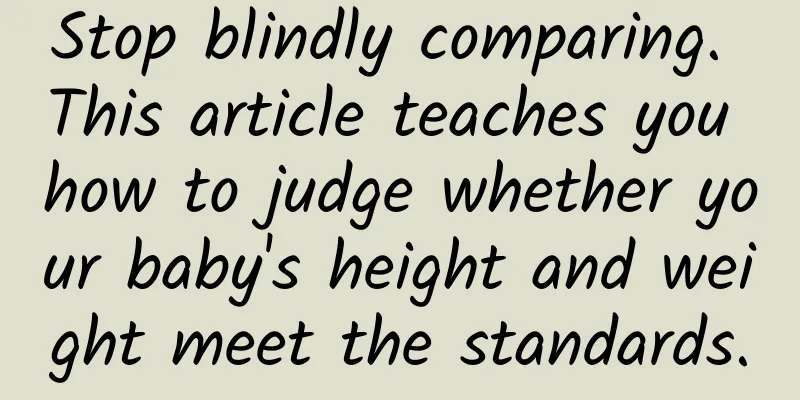Stop blindly comparing. This article teaches you how to judge whether your baby's height and weight meet the standards.

|
Author: Hu Fang, deputy chief physician, Women and Children's Medical Center, Guangzhou Medical University Reviewer: Dong Haipeng, Chief Physician, Women and Children's Medical Center, Guangzhou Medical University A child's height and weight are among the issues that parents are most concerned about. Only by mastering scientific monitoring and evaluation methods can parents better safeguard their children's health. 1. What is the reference standard for children’s height and weight? In clinical practice, parents often say, "Our child is almost the shortest in kindergarten," "The neighbor's child is two months younger than my child, but taller than my child." Is it appropriate to choose classmates or neighbors’ children as comparison (reference) standards? It is possible that your classmates or neighbors’ children are all tall, so making a comparison like this may not be scientific! To determine whether a child's height and weight meet the standards, we must first choose the right reference standard. Comparing the child's height and weight with the right reference standard is scientific. At present, there are two sets of standards that we commonly use, namely the World Health Organization's Child Growth and Development Evaluation Standards[1] and the "WS/T 423-2022 Growth Standards for Children Under 7 Years Old"[2] issued by the National Health Commission of China. By referring to the former, we can compare with children around the world, and by referring to the latter, we can compare with children in my country. 2. What is the standard for a child’s height and weight? How to compare a child's height and weight with the reference standards? Height and weight values are normally distributed in the population. 68.26% of people's height and weight are within one standard deviation of the average value of the reference standard, which is a medium level; 2.14% of people's height and weight are more than 2 standard deviations from the average value, which is a high level. Most people (97%) have height and weight distributions near the average value, and only a very small number of people (3%) are too tall/too fat, too short/too thin. Let's take the test scores (satisfying normal distribution) as an example. Assume that the average math score of the whole class is 80 points, and the standard deviation is 5 points. Xiaohong scored 60 points, which is 4 standard deviations less than the average score. So Xiaohong's score should be in the bottom 0.13% of the class, and the rating is low. Xiaolan scored 93 points, which is 2 standard deviations more than the average score. So Xiaolan's score should be in the top 3% of the class, and the rating is high. Similarly, we compare the child's height and weight with the average height and weight of children of the same gender and age to calculate the child's level in the population, which can be expressed using the standard deviation method or percentile method. Figure 1 Copyright image, no permission to reprint Scientists use the following boundary points to divide the grades according to the characteristics of the normal curve distribution. In this way, it can be judged whether the child's height and weight meet the standard. When the child's height and weight values are <3rd percentile, that is, <P3, or <(mean value-2 standard deviations), that is, Z <-2, it belongs to the "lower" level, which is abnormal; when the child's height and weight values are between P3 and P25, or the Z score is between -2 and -1, it belongs to the "lower middle" level; when the child's height and weight values are between P25 and P75, or the Z score is between -1 and +1, it belongs to the "middle" level; when the child's height and weight values are between P75 and P97, or the Z score is between +1 and +2, it belongs to the "upper middle" level; when the child's height and weight values are >P97 or Z> +2, it belongs to the "upper" level, which is abnormal. We believe that compared with the reference standard, Z scores of -2 to +2 or children's height and weight values between P3 and P97 are normal. 3. How to compare the child’s height and weight values with the reference standards? In order to help everyone quickly determine the height and weight level of their children, the National Health Commission has issued the "WS/T 423-2022 Growth Standards for Children Under 7 Years Old" [2], which gives the corresponding height and weight values for boys and girls at different age levels: P3, P10, P25, P50, P75, P90, and P97. For example, suppose a girl is 2 years old, 85cm tall and weighs 10kg. How do we know the height and weight of this girl? First, we need to find the two tables "Percentiles of weight for age of girls under 7 years old" and "Percentiles of height/height for age of girls under 7 years old" in "WS/T 423-2022 Growth Standards for Children under 7 Years Old". Then find the 2-year-old line in the table. We can see that the girl weighs 10kg, between P3 and P10, and is 85cm tall, between P25 and P50. Based on this result, it can be judged that the girl's height is at a medium level and her weight is at a lower-middle level, which is up to standard, but her weight is not as ideal as her height. Figure 2 Copyright image, no permission to reprint Figure 3 Copyright image, no permission to reprint -4. When evaluating a child’s height and weight, you also need to evaluate their growth rate It is not enough to just evaluate whether a child's height and weight meet the standard at a certain age. We also need to evaluate whether the child's growth rate is normal. Growth rate is determined by regularly measuring the child's height and weight, recording all measurement times and values, and obtaining the child's height and weight growth values over a period of time, thereby evaluating his or her growth rate. The figure below shows the height and weight growth curve of a baby obtained by regular measurements from birth to 13 months of age. Figure 4 Copyright image, no permission to reprint How to judge whether a child’s growth rate is normal? We plot the height and weight measurements of the child at each stage on this graph, and then connect the points in sequence to obtain a curve, and observe the relationship between this curve and the 7 lines in the standard curve. If the child's regular measurement values are all on the same level line on the growth curve, or fluctuate within the 2 main percentile lines, it means that the child's growth rate is normal. If the child's growth curve crosses the 2 main percentile lines upward or downward (such as from > P50 to close to P10), it means that the child's growth rate is abnormal. The baby above has a normal height growth rate, but his weight growth rate has begun to decline since he was 10 months old, which suggests that we should pay attention to find out the reason. Of course, we can also judge whether the child’s growth rate meets the standard based on the child’s growth and development rules. When a child's height growth is less than 7cm between the ages of 1 and 2, and less than 5cm per year between the ages of 2 and early puberty, slow height growth should be considered and the child should go to the hospital for treatment in a timely manner. 5. Notes (1) Regular continuous measurements are more important than one-time data. (2) The measured values of weight, height, and head circumference of normal children should be roughly in the same percentile. (3) The mean or P50 of height and weight is not the target of children's growth. The height and weight development of most children should proceed steadily along their own track. That is, multiple measurements should be near the same percentile line, and a certain fluctuation is allowed. (4) If a child’s growth curve deviates from the original stable growth trajectory by two major percentile lines, it indicates growth disorder. (5) When premature babies are young, their height and weight need to be corrected for age. References: [1]WHO Multicenter Growth Reference Study Group. WHO Child Growth Standards: Length/height-for-age, weight-for-age, weight-for-length, weight-for-height and body mass index-for-age: methods and development Geneva: WHO, 2006. [DB/OL]. [2024-8-12]. https://www.who.int/tools/child-growth-standards. [2] WS/T 423-2022 Growth standards for children under 7 years old[S]. National Health Commission of the People’s Republic of China. |
Recommend
Where do new growth opportunities come from for information flow advertising?
Native advertising, brand-effect integration, inf...
Hot sales of iPhone 6 cause Android's global market share to decline
Research firm Kantar Worldpanel ComTech (hereinaf...
The water purifier market is in chaos: the cost of a 2,800 yuan RO water purifier is less than 100 yuan
In the past two years, people have paid unpreceden...
Can ordinary people diagnose depression, mania, and bipolar disorder on their own?
Review expert: Chen Mingxin, national second-leve...
Zhihu traffic generation methods and techniques!
When I wrote this title, my Zhihu community had j...
Plastic, metal, glass... There are many different materials for mobile phone back covers. Which one is your favorite?
How did glass become the mainstream material for ...
World Immunization Week丨Why do we need to get vaccinated?
Why do we need to get vaccinated? Vaccination is ...
The changes are huge? What are the changes in Android 5.0?
Less than a year after the last major update of t...
Rebuilding the next Alibaba, Jack Ma’s glory and ambition
[[145683]] At present, Alibaba Group has a market...
China's grain distribution map: How much grain do the three northeastern provinces produce each year?
China's grain distribution map Where are the ...
Holiday brand marketing promotion skills and strategies!
Just as everyone has a difference between their t...
The latest cocktail party guide for ChinaJoy 2016 is here! (102 events updated at any time)
The annual ChinaJoy will be held in Shanghai from...
Teach you step by step the effective methods to improve your marketing and copywriting skills
As marketers , we generally have a good habit of ...
More than 90% of broadband speeds meet the standards. Have you met them?
Although the latest data released by the Ministry ...
How to authenticate Douyin Enterprise Blue V? Things to note when going through the Douyin Blue V certification process!
Enterprise Douyin certification process, Douyin B...









